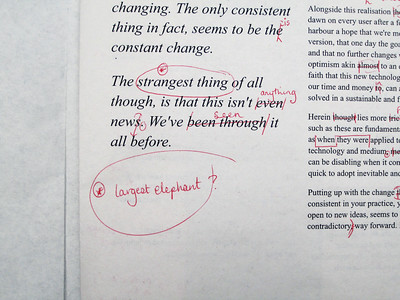English Composition I
Topic outline
-
Welcome to English Composition I!

Image: Welcome! by Jimmy_Joe, courtesy of Flickr. CC-BY 2.0.
Course Introduction
This course is the first of a two-course sequence designed to introduce entry-level undergraduate students to the basic skills and practices of writing necessary to writing successfully at the college level. The course covers numerous rhetorical modes common to academic writing in order to cultivate productive habits of ind, teach fundamental analytical moves, and establish a process-oriented approach to writing.The course covers key intellectual techniques as well as the building blocks of critical thinking. The skills that students learn in this course will serve to help them complete their baccalaureate degrees and, beyond that, to succeed in their lives beyond college. The ability to articulate thoughts in a clear and orderly manner as well as the ability to think analytically and critically are crucial for individuals to thrive in all segments of the contemporary workplace. These skills are also essential capacities for discerning, self-determining members of a functioning democracy.Upon successful completion of this course, the student will be able to:
- Use a flexible, multi-step, and recursive writing
process that includes prewriting, drafting, revising, editing, and
proofreading, while making use of written and oral feedback.
- Identify different rhetorical situations in order to respond with a clear purpose and with language appropriate for the intended audience and situation.
- Write academic essays through multiple drafts that consist of
logically-sequenced paragraphs including an engaging introduction, a supportive
body, and a conclusion that effectively ends the composition.
- Identify the use of persuasive strategies in written and visual arguments, use persuasive strategies in written arguments of their own, and construct effective thesis statements in multi-paragraph essays using specific rhetorical patterns of development and standard, edited English.
- Write essays demonstrating effective use of evidence in support of assertions and use rhetorically appropriate strategies to evaluate, represent, and respond to the ideas and research of others
- Use rules and conventions of grammar, word choice,
punctuation, and spelling in a variety of sentence structures.
Adopting institution should provide learners information on how to navigate the course. Consider adding an introductory navigation video. Text description could include, for example:Navigating the Course
This course is set up in modules covering various topics which may be accessed from the course navigation menu on the left or by scrolling below. Modules may be collapsed in the menu and it the body of the course to minimize scrolling. Each module includes the relevant chapters followed by various activities, which may include discussion forums, listening activities and quizzes, practice quizzes, module tests, and other relevant activities as appropriate for each module. Many items are required and may be marked as completed automatically when the activity has been submitted (the broken check box), but others will marked as done by the student (the solid check box).Please move through the items below and continue through the Learner Support and Getting Started modules before moving on to Module 1. Be sure to check for announcements and due dates to stay on track.
 This course and its contents are licensed under a Creative Commons Attribution 4.0 International License by LOUIS: The Louisiana Library Network, except where otherwise noted.
This course and its contents are licensed under a Creative Commons Attribution 4.0 International License by LOUIS: The Louisiana Library Network, except where otherwise noted. - Use a flexible, multi-step, and recursive writing
process that includes prewriting, drafting, revising, editing, and
proofreading, while making use of written and oral feedback.
-
This module contains all the items you should review and complete before you begin Module 1. Before moving on, be sure to:
- Check the News and Announcements Forum
- Read the Course Syllabus
- Introduce yourself to the class
- Read the instructions for the Q & A Forum
Good luck in the course!-
Use this forum to tell us a little about yourself and your interests. Some topic ideas:
- What is your field of study/research interest or concentration?
- What are you most interested in learning about in this class and why?
- Have you ever taken an online class before?
- Any other information you would like to share with your classmates, such as special interests or activities.
Post a picture! We look forward to meeting you.
-
Use this forum to ask your instructor any questions you have about the course. You may post at any time, and your instructor will respond here. Be as specific as possible.
Please keep in mind that others can see your posts, so do not post any personal information. If you have questions about your grade, please email your instructor directly. You can expect a response to posts and emails within 24 hours M-F or next business day on weekends and vacation days.
Subscription should be set to Auto.
- Check the News and Announcements Forum
-
Use the information in this module to customize the template to your needs. This module is currently hidden from students, and available for you to refer to throughout the semester.
-

After completing the diagnostic essay, students will identify techniques of factual storytelling and descriptive writing, which will culminate in the writing of a personal narrative essay. By using each stage of the writing process, students will demonstrate a clear understanding of point of view, plot, transitions, characters, conflict, theme, and sensory details. These skills will enable students to retell significant events with appropriate levels of detail in both personal and professional settings.
Upon completion of this module, you will be able to:- Identify different rhetorical situations in
order to respond with a clear purpose and with language appropriate for the
intended audience and situation.
- Use rules and conventions of grammar, word choice,
punctuation, and spelling in a variety of sentence structures.
To achieve these objectives:
- Read the Module 1 Introduction
- Read Chapter 5 on Narrative in Writing Rhetorically.
- Complete the two sets of discussion questions and the Your Turn Activity in this chapter.
- Review the Narrative and Description assignment sheet and the student worksheet.
- Identify different rhetorical situations in
order to respond with a clear purpose and with language appropriate for the
intended audience and situation.
-
 Students will identify techniques of descriptive writing, which will culminate in the writing of
a descriptive essay. By using each stage of the writing process, students will
demonstrate a clear understanding of sensory details and logical ways to order
them in an essay. These skills will enable students to organize information in personal and professional settings.
Students will identify techniques of descriptive writing, which will culminate in the writing of
a descriptive essay. By using each stage of the writing process, students will
demonstrate a clear understanding of sensory details and logical ways to order
them in an essay. These skills will enable students to organize information in personal and professional settings.Image: Swamp by Brian Ainsworth courtesy of Flickr. CC-BY-NC-ND 2.0.
Upon completion of this module, you will be able to:- Identify different rhetorical situations
in order to respond with a clear purpose and with language appropriate for the
intended audience and situation.
- Write academic essays through multiple drafts that consist of
logically-sequenced paragraphs including an engaging introduction, a supportive
body, and a conclusion that effectively ends the composition.
- Use a flexible, multi-step, and recursive writing process that includes prewriting, drafting, revising, editing, and proofreading, while interpreting written and oral feedback.
- Read the Module 2 Introduction
- Read Chapter 6 on Description in Writing Rhetorically.
- Complete the two sets of discussion questions and the Your Turn activity that appear in this chapter.
- Write the rough draft of your personal narrative essay.
- Identify different rhetorical situations
in order to respond with a clear purpose and with language appropriate for the
intended audience and situation.
-
Chapter 6: Description
-
 Students will learn and apply the first step in the writing process: invention. Invention includes prewriting strategies for generating topic ideas and gathering specific evidence. The emphasis is on content creation, not arranging ideas, drafting formal writing, revising, or editing. This chapter stresses the idea of writing as a multi-step process, whether the student is engaged in personal, academic, or professional writing.
Students will learn and apply the first step in the writing process: invention. Invention includes prewriting strategies for generating topic ideas and gathering specific evidence. The emphasis is on content creation, not arranging ideas, drafting formal writing, revising, or editing. This chapter stresses the idea of writing as a multi-step process, whether the student is engaged in personal, academic, or professional writing. Image: Et l'homme inventa la roue; et ce fut le début de sa fin... by Lou Gabian, courtesy of Flickr. CC-BY-NC-ND.
Upon completion of this module, you will be able to:-
Adopt and employ a flexible, multi-step, and recursive writing process that includes prewriting, drafting, revising, editing, and proofreading, while makine use of written and oral feedback.
-
Identify different rhetorical situations in order to respond with a clear purpose and with language appropriate for the intended audience and situation.
- Write essays demonstrating effective use of evidence in support of assertions and use rhetorically appropriate strategies to evaluate, represent, and respond to the ideas and research of others.
To achieve these objectives:
- Read the Module 3 Introduction
- Read Chapter 1 on Invention in Writing Rhetorically.
- Complete the Your Turn activity that appears in this chapter.
- Complete the final draft of your Narrative and Description paper.
-
-
Chapter 8: Illustration/Example
-

Students will learn to write a definition essay, which will accomplish: providing a clear, one-sentence definition, and provide details, specific examples and illustrations, narrative, and compare and contrast in order to flesh out that definition. Students will use both denotation and connotation when defining a term for an audience of their peers.
Image: Dictionary by www.quotecatalog.com courtesy of Flickr. CC-BY 2.0.Upon completion of this module, you will be able to:- Compose a clear, succinct definition of a nuanced term or concept.
- Illustrate a core definition by providing examples that represent the range of possible meanings of the term of concept.
Understand and apply the concepts of denotation and connotation to increase clarity of a term or concept's definition.
To achieve these objectives:
- Read the Module 4 Introduction
- Read chapter 7 on Definition in Writing Rhetorically.
- Complete the two sets of discussion questions and the Your Turn activity that appear in chapter 7.
- Review the Definition and Illustration assignment sheet and the student worksheet.
-

Students will write an essay using specific examples to illustrate their point. Students will differentiate between interesting, specific examples and general statements. The chapter emphasizes the importance of well-chosen evidence, whether from personal experience or through academic research, when proving a thesis.
Image: Beach Cabins by Sandra Strait, courtesy of Flickr. CC-BY-NC-ND 2.0.Upon completion of this module, you will be able to:- Determine the purpose and structure of the illustration essay
- Understand how to write an illustration essay
To achieve these objectives:
- Read the Module 5 Introduction
- Read chapter 8 on Example/Illustration in Writing Rhetorically.
- Complete the two sets of discussion questions and the Your Turn activity that appear in chapter 8.
- Write the rough draft of your Definition and Example/Illustration paper.
-
Chapter 11: Cause and Effect
-

Arrangement refers to the organization and structure of ideas in an essay. Choosing the right structure depends on the application of critical thinking to select the best fit for your purpose. Arrangement is an important step between Invention and Drafting where writers organize their ideas into a plan to use as a roadmap to guide the written draft.
Image by Lenore Edman courtesy of Flickr. CC-BY 2.0.
Upon completion of this module, you will be able to:
- Identify the parts of an essay
- Evaluate the appropriate rhetorical pattern for the topic and task
- Demonstrate components of an effective introduction, body, and conclusion
- Define the purpose of citation
To achieve these objectives:
- Read the Module 6 Introduction
- Read and view the materials in chapter 2 on Arrangement and chapter 13 on MLA Research and Citation in Writing Rhetorically.
- Complete the Your Turn activity that appears in chapter 2.
- Complete the final draft of your Definition and Example/Illustration paper.
- Identify the parts of an essay
-

In the previous module, you learned how to evaluate a specific item, person, place, or phenomenon. And now we need to put that knowledge to further use--being able to evaluate something is the first step to evaluating similar or related things--and this skill is one you'll practice at work and in private. Life is full of choices--you'll have to compare and contrast them.
Image: Comparing... by ericaxel courtesy of Flickr. CC-BY 2.0.
Upon completion of this module, you will be able to:
- Define the purpose and structure of the compare and contrast essay
- Produce a compare and contrast essay
To achieve these objectives:
- Read the Module 7 Introduction
- Read and view the materials in chapter 9 on Comparing and Contrasting in Writing Rhetorically.
- Complete the two sets of discussion questions and the Your Turn activity that appear in chapter 9.
- Review the Compare and Evaluate assignment sheet and the student worksheet.
-
 Having practiced description and narrative, students will now begin learning and practicing how to evaluate activities/events, objects, people, places, etc. In thinking about evaluation, it is important to remember that we are always evaluating all sorts of things, and this unit will build on that existing knowledge. By seeing how opinions merge with evidence, students will learn to make well-informed judgements, which they will be asked to do in work environments and their personal lives.
Having practiced description and narrative, students will now begin learning and practicing how to evaluate activities/events, objects, people, places, etc. In thinking about evaluation, it is important to remember that we are always evaluating all sorts of things, and this unit will build on that existing knowledge. By seeing how opinions merge with evidence, students will learn to make well-informed judgements, which they will be asked to do in work environments and their personal lives. Image: Scales by Dominic Melton, courtesy of Flickr. CC-BY 2.0.
Upon completion of this module, you will be able to:
- Define judgement and criteria that are appropriate to the object of evaluation
- Evaluate using these judgment and criteria
To achieve these objectives:
- Read the Module 8 Introduction
- Read and view the materials in chapter 10 on Evaluation of Writing Rhetorically.
- Complete the two sets of discussion questions and the Your Turn activity in chapter 10.
- Complete the rough draft of your Comparison and Evaluation paper.
-
 As much as writing is about producing an essay for us, it is just as important a question of process--how do we produce successive drafts and how do you improve on the first draft, revising it into the last? This chapter will explain some strategies for drafting and getting words on the page or screen. Revision comes next, as those drafts have to be reimagined, changed, and reorganized often to produce a good, final draft. Revision is literally about seeing again, and it's important to remember this isn't proofing or editing necessarily.
As much as writing is about producing an essay for us, it is just as important a question of process--how do we produce successive drafts and how do you improve on the first draft, revising it into the last? This chapter will explain some strategies for drafting and getting words on the page or screen. Revision comes next, as those drafts have to be reimagined, changed, and reorganized often to produce a good, final draft. Revision is literally about seeing again, and it's important to remember this isn't proofing or editing necessarily. Image: NYC, 40 Bond, Gate, Draft Design by Detlef Schoberg, courtesy of Flickr. CC-BY-ND. 2.0.
Upon completion of this module, you will be able to:
- Define drafting and revision
- Develop strategies for drafting and revision
To achieve these objectives:
- Read the Module 9 Introduction.
- Read and view the materials in chapter 3 on Drafting and Revision in Writing Rhetorically.
- Complete the TWO Your Turn activities in chapter 3.
- Using the draft you produced in the first Your Turn activity for chapter 3, practice making a reverse outline and then, separately, read your essay aloud to a peer. Include the reverse outline in the document file with your rough draft.
For additional feedback on your draft, make an appointment with a writing center or tutor, if possible.
- Define drafting and revision
-
 The cause and effect essay details the reasons for (causes) and the outcomes of (effects) an event, condition, or decision. The purpose of the cause and effect essay is to determine how various phenomena relate. The essay attempts to discover either the origins of something, the effects or results that can be properly attributed to it, or both. For example, a single cause can produce many different effects, or a single effect may have several causes. Understanding the significance and relationships among causes and the relationships, effects, or both are important elements of the cause and effect essay.
The cause and effect essay details the reasons for (causes) and the outcomes of (effects) an event, condition, or decision. The purpose of the cause and effect essay is to determine how various phenomena relate. The essay attempts to discover either the origins of something, the effects or results that can be properly attributed to it, or both. For example, a single cause can produce many different effects, or a single effect may have several causes. Understanding the significance and relationships among causes and the relationships, effects, or both are important elements of the cause and effect essay. Image: Dominos by Phillip Taylor, courtesy of Flickr. CC-BY-SA 2.0.
Upon completion of this module, you will be able to:
- Distinguish between causes and effects of an event, condition, or decision
- Determine the significance and relationship among causes and effects
- Apply each phase of the writing process to create a cause and effect essay
To achieve these objectives:
- Read the Module 10 Introduction
- Read and view the materials in chapter 11 on Cause and Effect in Writing Rhetorically.
- Complete the two sets of discussion questions and the Your Turn Activity in chapter 11.
- Review the Cause/Effect and Argument paper assignment sheet and the student worksheet.
- Distinguish between causes and effects of an event, condition, or decision
-
 Argumentation is a process of reasoning that asserts the reasonableness of a position, belief, or conclusion. An effective argumentative essay introduces a compelling, debatable topic to engage the reader. The purpose of the argument essay is to establish the writer's opinion or position on a topic and persuade others to share or at least acknowledge the validity of the writer's opinion in a fair, logical, and engaging process.
Argumentation is a process of reasoning that asserts the reasonableness of a position, belief, or conclusion. An effective argumentative essay introduces a compelling, debatable topic to engage the reader. The purpose of the argument essay is to establish the writer's opinion or position on a topic and persuade others to share or at least acknowledge the validity of the writer's opinion in a fair, logical, and engaging process. Image: Debate na UFMG by Eu Governo, courtesy of Flickr. CC-BY-SA 2.0.
Upon completion of this module, you will be able to:
- Identify the elements of an argumentative essay
- Determine the structure of an argumentative essay
- Apply each phrase of the writing process to create an argumentative essay
To achieve these objectives:
- Read the Module 11 Introduction
- Read and view the materials in chapter 12 on Argument in Writing Rhetorically.
- Complete the two sets of discussion questions and the Your Turn activity that appear in chapter 12.
- Write the rough draft of your Cause/Effect and Argument paper.
- Identify the elements of an argumentative essay
-
Students will identify multiple techniques of editing and proofreading. Students will use content editing, line editing, copyediting, and proofreading in order to identify common mistakes in essay writing. Then, students will apply these concepts by modifying an essay previously written for the course.
Image: The Review, Part 2 by With Associates, courtesy of Flickr. CC-BY-SA 2.0.
Upon completion of this module, you will be able to:
- Use rules and conventions of grammar, word choice, punctuation, and spelling in a variety of sentence structures.
- Use a flexible, multi-step, and recursive writing process that includes prewriting, drafting, revising, editing, and proofreading, while interpreting written and oral feedback.
- Write academic essays through multiple drafts that consist of logically-sequenced paragraphs including an engaging introduction, a supportive body, and a conclusion that effectively ends the composition.
To achieve these objectives:
- Read the Module 12 Introduction
- Read chapter 4 on Editing and Proofreading in Writing Rhetorically.
- Complete the Your Turn exercise in chapter 4.
- Complete the final draft of the Cause/Effect and Argument paper.
- Use rules and conventions of grammar, word choice, punctuation, and spelling in a variety of sentence structures.
